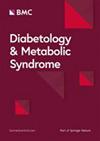Comparison of the correlation of creatinine- and cystatin C–Based estimated GFR and their differences with new-onset heart failure in a community-based population with type 2 diabetes
IF 3.4
3区 医学
Q2 ENDOCRINOLOGY & METABOLISM
引用次数: 0
Abstract
This study aimed to investigate the impact of different estimated glomerular filtration rate (eGFR) values like cystatin C-based eGFR (eGFRcys), creatinine-based eGFR (eGFRcr), and their difference (eGFRdiff; eGFRcys -eGFRcr), on the incidence of heart failure (HF) in patients with type 2 diabetes(T2D). Being a prospective cohort study, it included 7,967 patients with T2D who underwent serum creatinine and cystatin C tests as part of the Kailuan Group’s 6th annual health examination (2016). Subsequently, eGFRcys, eGFRcr, and eGFRdiff were calculated. Patients were categorized into three groups: negative (<-15 mL/min/1.73 m2), midrange (-15 to 15 mL/min/1.73 m2), and positive (> 15 mL/min/1.73 m2) eGFRdiff groups, respectively. Furthermore, the relationship between the various eGFR measurements and new-onset HF were studied using Cox proportional hazards regression, and the potential improvement in predictive capability was evaluated by adding these eGFR metrics to established HF risk models. Among 7967 participants with mean age of 60.51 years, there were 20.92% women and 79.08% men. At baseline, eGFRcys and eGFRcr values differed by more than 15 mL/min/1.73m2 in 41.3% of participants. During a median follow-up period of 3.76 years, there were 172 (2.16%) new HF cases and 517 (6.49%) all-cause deaths. The cumulative incidence of HF in the midrange, negative, and positive eGFRdiff groups was 1.74%, 4.10%, and 0.61%, respectively (p < 0.001). In multivariable adjusted models, participants in the negative eGFRdiff group had higher risk of HF compared with the midrange eGFRdiff group (HR, 2.15; 95% CI, 1.57–2.94). Conversely, participants in the positive eGFRdiff group had lower risk for HF (HR, 0.40; 95% CI, 0.17–0.93). And each 15 mL/min/ 1.73 m2 higher eGFRdiff was associated with 34% (HR, 0.66; 95% CI, 0.58 − 0.47)lower risk of incident HF. The predictive capacity for HF risk in diabetic individuals was enhanced by adding eGFRcys or eGFRdiff to established HF risk models, with eGFRcys showing more significant additional predictive value. These findings suggest that large differences between eGFRcys and eGFRcr were common in community-based population with T2D. Different eGFR metrics can independently predict HF incidence in patients with T2D. Additionally, metrics like eGFRcys and eGFRdiff provide significant predictive value for HF risks beyond traditional risk factors, with eGFRcys showing more pronounced benefits in such cases.比较基于肌酐和胱抑素 C 的估计 GFR 与社区 2 型糖尿病患者新发心力衰竭的相关性及其差异
本研究旨在探讨不同的估计肾小球滤过率(eGFR)值,如基于胱抑素C的eGFR(eGFRcys)、基于肌酐的eGFR(eGFRcr)以及它们之间的差异(eGFRdiff;eGFRcys -eGFRcr)对2型糖尿病(T2D)患者心力衰竭(HF)发病率的影响。作为一项前瞻性队列研究,该研究纳入了开滦集团第六次年度体检(2016年)中接受血清肌酐和胱抑素C检测的7967名2型糖尿病患者。随后,计算出 eGFRcys、eGFRcr 和 eGFRdiff。患者被分为三组:分别为 eGFRdiff 阴性组(15 mL/min/1.73 m2)和 eGFRcys 阴性组(15 mL/min/1.73 m2)。此外,还使用 Cox 比例危险回归法研究了各种 eGFR 测量值与新发 HF 之间的关系,并评估了将这些 eGFR 指标添加到已建立的 HF 风险模型中对预测能力的潜在改进。在平均年龄为 60.51 岁的 7967 名参与者中,女性占 20.92%,男性占 79.08%。基线时,41.3% 的参与者的 eGFRcys 和 eGFRcr 值相差超过 15 毫升/分钟/1.73 平方米。在中位 3.76 年的随访期间,共有 172 例(2.16%)新发高血压病例和 517 例(6.49%)全因死亡病例。eGFRdiff 中值组、阴性组和阳性组的心房颤动累积发病率分别为 1.74%、4.10% 和 0.61%(p < 0.001)。在多变量调整模型中,阴性 eGFRdiff 组的参与者与中档 eGFRdiff 组相比,患心房颤动的风险更高(HR,2.15;95% CI,1.57-2.94)。相反,eGFRdiff 阳性组的参与者患心房颤动的风险较低(HR,0.40;95% CI,0.17-0.93)。eGFRdiff 每升高 15 mL/min/ 1.73 m2,发生 HF 的风险就降低 34% (HR,0.66;95% CI,0.58 - 0.47)。将 eGFRcys 或 eGFRdiff 加入已建立的心房颤动风险模型后,糖尿病患者的心房颤动风险预测能力得到增强,其中 eGFRcys 显示出更显著的额外预测价值。这些发现表明,eGFRcys 和 eGFRcr 之间的巨大差异在以社区为基础的 T2D 患者中很常见。不同的 eGFR 指标可以独立预测 T2D 患者的房颤发病率。此外,eGFRcys 和 eGFRdiff 等指标对传统风险因素之外的心房颤动风险具有显著的预测价值,而 eGFRcys 在这种情况下的优势更为明显。
本文章由计算机程序翻译,如有差异,请以英文原文为准。
求助全文
约1分钟内获得全文
求助全文
来源期刊

Diabetology & Metabolic Syndrome
ENDOCRINOLOGY & METABOLISM-
CiteScore
6.20
自引率
0.00%
发文量
170
审稿时长
7.5 months
期刊介绍:
Diabetology & Metabolic Syndrome publishes articles on all aspects of the pathophysiology of diabetes and metabolic syndrome.
By publishing original material exploring any area of laboratory, animal or clinical research into diabetes and metabolic syndrome, the journal offers a high-visibility forum for new insights and discussions into the issues of importance to the relevant community.
 求助内容:
求助内容: 应助结果提醒方式:
应助结果提醒方式:


